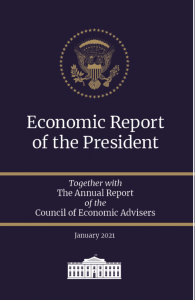Is out, here.
Guest Contribution: “The Impact of COVID-19 on Emerging Financial Markets”
Today, we are pleased to present a guest contribution by Steven Kamin (AEI), formerly Director of the Division of International Finance at the Federal Reserve Board. The views presented represent those of the authors, and not necessarily those of the institutions the authors are affiliated with.
The Outlook: WSJ January Survey
Upgrades in forecasted growth rates, largely due to expectations of widespread vaccinations.
Interpreting Spreads
Here is a graph of two spreads oft-cited: (1) a term spread, the 10 year-3 month spread, and (2) a spread between a nominal rate and a real rate, the 10 year Treasury yield and 10 year TIPS yield, commonly interpreted as the inflation breakeven. (I leave the credit spread for another post.)
Spreads and Risk over the Past Week (and Months)
I’ve been amazed at how little the last week’s political turmoil has shown up in financial markets. The only thing that seems to have moved anything is the apparent control of the Senate moving to the Democrats.
The Strong Dollar Debate, Yet Again
(Somewhat repetitive of a 2007 post…)
“Richard Cooper, cutting-edge economist”
That’s from the title of a Harvard Gazette article today:
Most economists live in the world of theory, using careful calculations to predict the future. But Richard N. Cooper believed theory couldn’t tell the whole story when it came to solving real-world problems, particularly when they involve the whole world — which he amply demonstrated after a global recession in the 1970s.
Winning (per Trump Dictionary)! US-China Trade
Chad Bown, US-China Phase 1 Tracker:
No matter how you look at it – use data on China’s imports or US exports – through November, China purchased only slightly more than half of the US goods Trump pledged it would buy over all of 2020 under his Phase One deal.
Downside Employment Surprise and Business Cycle Indicators as of January 8th
Nonfarm payroll (NFP) employment down 100 thousand, contra +81 Bloomberg consensus, even worse than GS and DB.
A Darkening Short Term Outlook
Goldman Sachs prediction for December NFP is -50 thousand, and Deutsche Bank is -75 thousands. The current Bloomberg consensus of +71 thousand (down from +100 thousand on the 6th).
